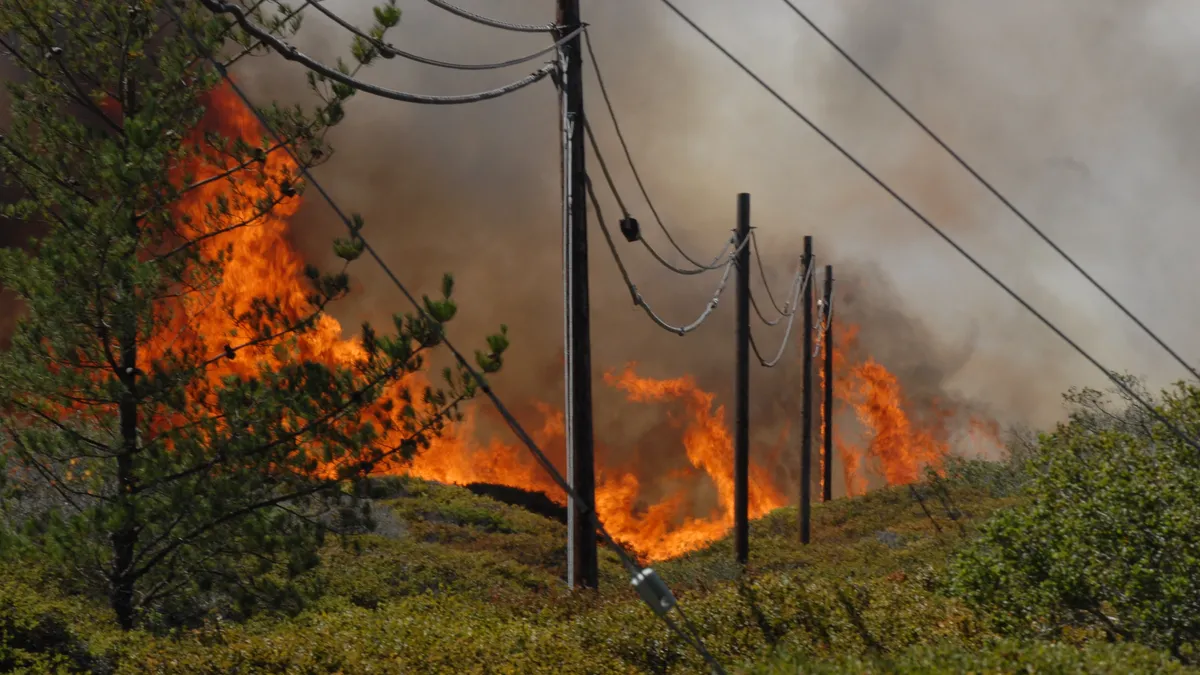Dive Brief:
-
Power lines owned by Pacific Gas & Electric (PG&E) were the cause of the Cascade fire that killed four and burned nearly 10,000 acres in California last year, state fire officials announced on Tuesday.
-
Sagging transmission lines came into contact during high winds to cause the fire, CAL FIRE said in a Tuesday release. The report was provided to local prosecutors, who said they would not press charges against the utility.
-
PG&E previously warned that liability costs related to multiple fires started by its equipment could force it to restructure the company or enter bankruptcy protection, but California lawmakers last month passed a new law to limit the utility's liability with wildfires going forward.
Dive Insight:
California's wildfires pose significant financial risks for PG&E and highlight how utility infrastructure will be put at increasing risk by a warming climate.
The new finding from CAL FIRE means PG&E has now been found responsible for 16 fires in Northern California last year, the Sacramento Bee notes, though state officials have yet to release an investigation into the Tubbs Fire, which killed 24 people.
In the Cascade fire, officials said PG&E lines came into contact in an incident referred to as a "line slap."
"A high wind event in conjunction with the power line sag on two conductors caused the lines to come into contact, which created an electrical arc," CAL FIRE said in a release. "The electrical arc deposited hot burning or molten material onto the ground in a receptive fuel bed causing the fire."
PG&E did not violate any state regulations to start the fire, officials said, but referred the report to the district attorney’s office in Yuba County.
The office reviewed the report for evidence of negligent homicide on the part of PG&E but said in a release that a jury was unlikely to unanimously agree to support those charges.
“Given these conclusions, prosecutors are ethically obligated not to proceed with a criminal prosecution,” the office said, though civil charges could still be filed.
California's insurance laws hold the utility accountable if its equipment starts the fire, regardless of legal status.
PG&E warned investors this summer that it would take at least a $2.5 billion charge to pay for 2017 wildfire expenses, and analysts estimate those costs could grow to $12 billion.
In June, PG&E officials told state lawmakers that the expenses could force the utility into bankruptcy or compel it to break the company into several pieces. The legislature responded by passing a bill backed by Gov. Jerry Brown that could protect utility shareholders from some of the most serious expenses.
While the bill does not alter utility liability, it allows utilities to recover some wildfire costs retroactively and establishes a new standard for determining how they can charge customers for wildfire expenses in the future. Interpretation of those standards will be largely left up to the Public Utilities Commission.
Regardless of its liability, PG&E has warned that it will face more and larger fires in the future as a warmer climate creates more dangerous conditions for blazes. Already this year, CAL FIRE says it has dealt with more than 5,200 fires that burned more than 621,000 acres, up considerably from the five year average of 4,900 fires a year burning 215,000 acres.
"[E]xtreme weather conditions that we experienced in 2017 have continued, resulting in the worst wildfire in the state’s history in 2018," PG&E said in a Tuesday release. "Clearly, our state requires comprehensive new solutions.













